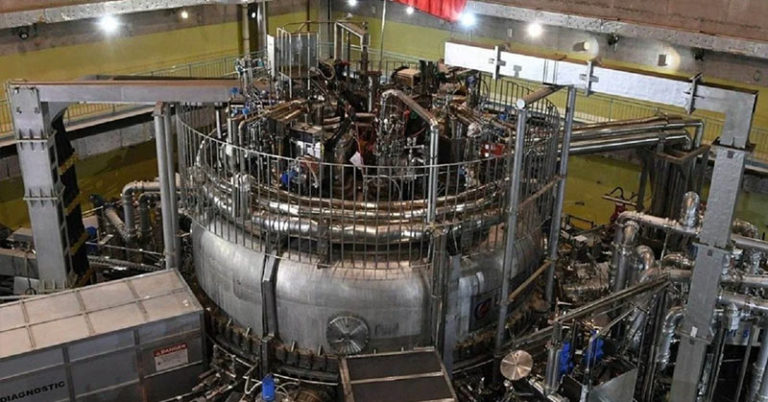For the first time ever, researchers in China have officially turned on their “artificial sun” nuclear fusion reactor.
Fusion is what powers our sun, and scientists consider it the “holy grail” of energy production [1]. This makes it one of the only potential alternatives for producing energy on a larger scale [2]. If this reactor is successful, it could have massive implications for the sustainable energy industry.
What is China’s “Artificial Sun”?
In short, this artificial sun is a tokamak, or a nuclear fusion experimental research device. The term “tokamak” comes from shortening the Russian words for “toroidal magnetic confinement”. Essentially, it is a torus (that is the math term for donut) that traps extremely hot plasma and presses it into making chemical reactions [3].
Here’s how the artificial sun tokamak works:
- Air and impurities are removed from the doughnut-shaped vacuum chamber.
- Scientists charge up the massive magnetic coils that surround the chamber.
- They then introduce a gaseous hydrogen fuel into the chamber.
- A powerful electrical current runs through the vessel, turning the gas into a hot, electrically charged gas, aka plasma.
- As the plasma particles gain energy, they collide and also begin to heat up. Supplementary heating methods help make the plasma hot enough for fusion. This is between 150 and 300 million degrees celsius.
- This high temperature causes the particles to fuse, which releases huge amounts of energy [4].
Hundreds of labs around the world have been experimenting with small tokamaks for decades. The magnetic fields around the devices, however, are prone to imperfections, and controlling them is very challenging. Studying tokamaks has taken many years, and has often seemed impossible to implement on a larger scale.
China’s artificial sun, however, is proving that large-scale energy production using a tokamak may be possible.
Fusion Vs. Fission
Both fusion and fission are nuclear reactions that produce energy, but there are a few key differences:
Fission: When you split a heavy, unstable nucleus into two lighter nuclei.
Fusion: You combine two light nuclei together, which releases vast amounts of energy. This is what powers the sun (hence why the reactor in China is called the “artificial sun”.
The reason why we have traditionally used fission in nuclear power reactors is because we can control it. Fusion, on the other hand, is much more difficult to control. It is also extremely expensive to create the conditions you need in order to produce a fusion reaction [5].
Is This Artificial Sun Safe?
One of the biggest concerns with nuclear fusion reactors is safety. When you hear the term “nuclear power”, the first thing that comes to many people’s minds is the Chernobyl disaster of 1986. The second thing is usually the Cold War between the US and Russia.
Both of these instances, however, involved nuclear fission. Nuclear fusion, on the other hand, is safer for three main reasons:
- Nuclear fusion does not use fissile materials like uranium and plutonium. This means that there are no enriched materials in a fusion reactor that someone could use to make nuclear weapons.
- Tokamaks would not produce any high activity or long-life nuclear waste. This is because the fuel it “burns” is helium, which is a non-radioactive gas. The only radioactive materials in the system are Tritium, the fuel, and materials that become active while the machine is running.
- A “runaway” reaction and the uncontrolled production of energy that would ensue is not possible with nuclear fusion. This is because you can’t maintain a fusion reaction without an external stimulus. If you disturb the reaction, or there is any failure at any point, it will just stop. Even if the cooling function of the reactor failed, the temperatures of the vacuum vessel will not reach the melting temperatures of the materials the vessel is made of, thanks to the magnetic field containing the heat [2].
The Sun is On
The Experimental Advanced Superconducting Tokamak (EAST) team has been working on this project for years, and are finally making headway. The last time the team made headlines was in 2018 when the tokamak reached 180 million degrees Celsius for ten seconds.
The EAST team says that they plan on reaching the artificial sun’s optimal operating temperature of 360 million degrees by the end of this year. Now, the researchers have officially switched it on [6].
They are collaborating closely with scientists working on the International Thermonuclear Experimental Reactor (ITER) in France. This is the largest nuclear fusion research project in the world, which is set to be complete in 2025 [7].
If the EAST team’s artificial sun is successful, it could have a major significance for the future of sustainable energy development. Whether or not the extraordinary cost of the project (to the tune of tens of billions of dollars) will be worth it, remains to be seen.
Sources
- ‘China turns on nuclear-powered ‘artificial sun’ Phys. Published December 4, 2020
- ‘Frequently Asked Questions’ ITER
- ‘China Is Building an Artificial Sun’ Popular Mechanics Caroline Delbert. Published December 20, 2019
- ‘What is a TOKAMAK?’ ITER
- ‘Fission vs. Fusion – What’s the Difference?’ Duke Energy. Published January 30, 2013.

